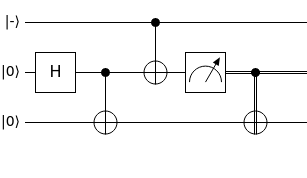This circuit:
The first (upper) qubit is the one we want to teleport, so could start it any state, call $\alpha|0\rangle+\beta|1\rangle$. Our goal is to teleport it to the third (bottom) bit.
After entangling the second and third bits, we have
$$\frac{1}{\sqrt2}\Big(\alpha(|0\rangle\otimes(|00\rangle+|11\rangle))+\beta(|1\rangle\otimes(|00\rangle+|11\rangle))\Big)$$
After applying CNOT from the first to second bit, we have
$$\frac{1}{\sqrt2}\Big(\alpha(|0\rangle\otimes(|00\rangle+|11\rangle))+\beta(|1\rangle\otimes(|10\rangle+|01\rangle))\Big)$$
At this point, we measure the second qubit. If it's $|0\rangle$, then we end up in the state
$$\alpha(|0\rangle\otimes|00\rangle)+\beta(|1\rangle\otimes|01\rangle)=\alpha|000\rangle+\beta|101\rangle$$
If it's $|1\rangle$, then we end up in
$$\alpha(|0\rangle\otimes|11\rangle)+\beta(|1\rangle\otimes|10\rangle)=\alpha|011\rangle+\beta|110\rangle$$
In this case, we apply X to the third bit, yielding
$$\alpha|010\rangle+\beta|111\rangle$$
In either case, if we have access to the third qubit only, it appears to be in the state $\alpha|0\rangle+\beta|1\rangle$, which is what we want. What's wrong with this scheme? The only thing I can think of is that it "doesn't count" as teleportation because the first and third qubits are still entangled at the end. But I thought the main point of teleportation was just to transmit a state using only classical data and a pre-entangled pair, in which case this does seem to "count".

